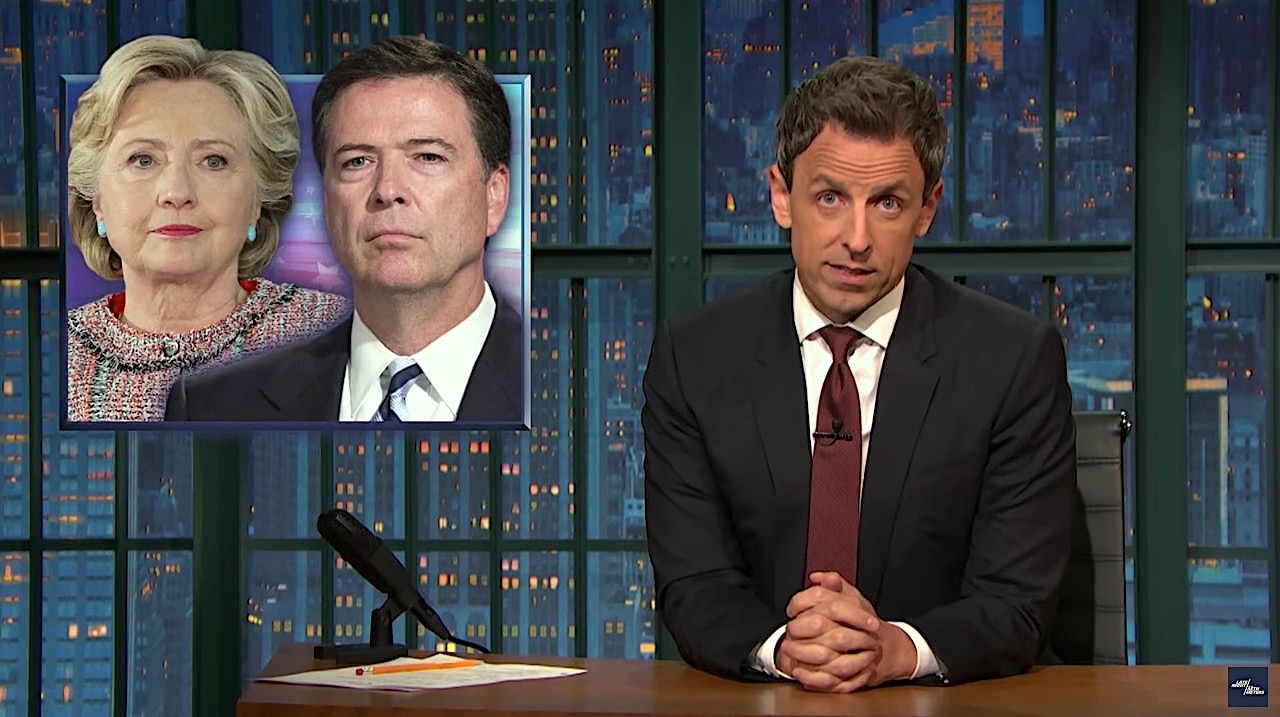Seth Meyers has an alternate theory on what sparked the new FBI Clinton email hunt


Hillary Clinton's double-digit lead in the polls last week had her in a very good mood — maybe too good, Seth Meyers said on Monday's Late Night. She even proposed on a talk radio program that America needs a national dance party to lighten its mood. Meyers said that would be a terrible idea. "This threat, this very, very serious threat of a national arms-only dance party led by Hillary Clinton caught the attention of the FBI, who realized they had to do something to dampen her spirits," Meyers said.
That of course would be FBI Director James Comey's vague letter to Congress, informing lawmakers of... something about emails. Comey's "ambiguity bomb" of a letter was "so vague, it was like the entire country got a voicemail from the FBI director just saying, 'We need to talk,'" Meyers said. "Donald Trump still hasn't released his tax returns, 12 women have accused him of sexual assault, and he's going on trial for fraud for Trump University in November, but now the only thing the media's talking about is emails," he said. "It's like if during the O.J. trial everyone was focused on whether or not the Ford Bronco had up-to-date registration."
When Meyers got down to brass tacks, he quickly decided Anthony Weiner and details were not a good combination. "Now this latest news has revealed the hypocrisy on display in both parties," Meyers said, with each party switching sides on how they feel about Comey. And Comey himself was concerned that his letter would be misconstrued. "In terms of being misunderstood, don't worry, because our media always behaves calmly and rationally when it comes to potential Clinton scandals," Meyers snarked, with justification. "They would never baselessly speculate."
The Week
Escape your echo chamber. Get the facts behind the news, plus analysis from multiple perspectives.

Sign up for The Week's Free Newsletters
From our morning news briefing to a weekly Good News Newsletter, get the best of The Week delivered directly to your inbox.
From our morning news briefing to a weekly Good News Newsletter, get the best of The Week delivered directly to your inbox.
But this is about more than just the FBI and Clinton and emails, Meyers concluded. "Now we've got Republicans basically foaming at the mouth for another four years of paralyzing political dysfunction," and they were planning for that even before the latest FBI move, he said. "And this kind of permanent investigation where you subject your political opponents to constant hounding and never ending legal proceedings is paralyzing our political system." Watch below. Peter Weber
A free daily email with the biggest news stories of the day – and the best features from TheWeek.com
Peter has worked as a news and culture writer and editor at The Week since the site's launch in 2008. He covers politics, world affairs, religion and cultural currents. His journalism career began as a copy editor at a financial newswire and has included editorial positions at The New York Times Magazine, Facts on File, and Oregon State University.
-
 A luxury walking tour in Western Australia
A luxury walking tour in Western AustraliaThe Week Recommends Walk through an ‘ancient forest’ and listen to the ‘gentle hushing’ of the upper canopy
-
 What Nick Fuentes and the Groypers want
What Nick Fuentes and the Groypers wantThe Explainer White supremacism has a new face in the US: a clean-cut 27-year-old with a vast social media following
-
 5 highly amusing cartoons about rising health insurance premiums
5 highly amusing cartoons about rising health insurance premiumsCartoon Artists take on the ACA, Christmas road hazards, and more
-
 Son arrested over killing of Rob and Michele Reiner
Son arrested over killing of Rob and Michele ReinerSpeed Read Nick, the 32-year-old son of Hollywood director Rob Reiner, has been booked for the murder of his parents
-
 Rob Reiner, wife dead in ‘apparent homicide’
Rob Reiner, wife dead in ‘apparent homicide’speed read The Reiners, found in their Los Angeles home, ‘had injuries consistent with being stabbed’
-
 Hungary’s Krasznahorkai wins Nobel for literature
Hungary’s Krasznahorkai wins Nobel for literatureSpeed Read László Krasznahorkai is the author of acclaimed novels like ‘The Melancholy of Resistance’ and ‘Satantango’
-
 Primatologist Jane Goodall dies at 91
Primatologist Jane Goodall dies at 91Speed Read She rose to fame following her groundbreaking field research with chimpanzees
-
 Florida erases rainbow crosswalk at Pulse nightclub
Florida erases rainbow crosswalk at Pulse nightclubSpeed Read The colorful crosswalk was outside the former LGBTQ nightclub where 49 people were killed in a 2016 shooting
-
 Trump says Smithsonian too focused on slavery's ills
Trump says Smithsonian too focused on slavery's illsSpeed Read The president would prefer the museum to highlight 'success,' 'brightness' and 'the future'
-
 Trump to host Kennedy Honors for Kiss, Stallone
Trump to host Kennedy Honors for Kiss, StalloneSpeed Read Actor Sylvester Stallone and the glam-rock band Kiss were among those named as this year's inductees
-
 White House seeks to bend Smithsonian to Trump's view
White House seeks to bend Smithsonian to Trump's viewSpeed Read The Smithsonian Institution's 21 museums are under review to ensure their content aligns with the president's interpretation of American history
